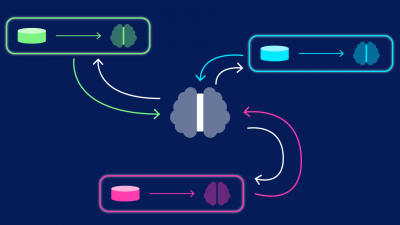Augmented reality has evolved dramatically since its early days. Where developers once had to meticulously craft every element of an AR experience, generative AI now enables the creation of dynamic, responsive environments that can adapt to user interactions in real-time. This technological shift is changing not just how AR content is made, but what’s possible within these immersive spaces.
The fusion of generative AI with augmented reality opens extraordinary possibilities for marketing professionals. As these technologies converge, brands can deliver experiences that were previously restricted to science fiction.
How Generative AI Enhances AR Content Creation
Generative AI streamlines AR development by automating complex content creation processes. Traditional AR development required extensive manual asset creation, often demanding weeks of work from specialized teams. Generative AI can now produce these assets in minutes or seconds.
This acceleration transforms the economics of AR deployment. Projects that once required significant investment can now be developed with smaller budgets and faster timelines, making immersive experiences accessible to businesses of all sizes.
Beyond mere efficiency, generative AI enables truly dynamic content. AR environments can now respond intelligently to user behavior, environmental conditions, and contextual information, creating experiences that feel alive.
Real-Time Asset Generation
One of the most powerful applications of generative AI in AR is real-time asset generation. Instead of downloading pre-made assets, AI can create elements on demand based on user context, preferences, or actions.
A furniture retailer’s AR app can instantly generate customized furniture designs that match a customer’s existing décor. When the customer changes their preferences, the AI adapts immediately, showing variations without requiring pre-built 3D models for every possible configuration.
This capability dramatically reduces storage requirements while expanding creative possibilities. Users receive perfectly tailored content without developers needing to anticipate every possible scenario.
Personalized AR Experiences
Generative AI enables unprecedented personalization in AR experiences. By analyzing user data and behavior patterns, these systems can craft unique content for each individual.
Consider an AR marketing campaign that adapts its messaging and visual style based on user preferences. One person might see a sleek, minimalist presentation while another receives rich, detailed imagery—both generated in real-time by the same core experience but tailored to individual aesthetic sensibilities.
This personalization extends to interactive elements as well. Generative AI can create custom challenges, narratives, or information pathways that resonate with specific users, increasing engagement and conversion rates.
Creating Responsive Environments
Traditional AR overlays digital content onto the real world but often fails to meaningfully interact with that environment. Generative AI transforms this relationship by creating content that responds intelligently to real-world spaces.
Advanced AR applications now use AI to analyze physical environments and generate content that integrates seamlessly with reality. An AR marketing installation might spawn digital elements that flow around physical obstacles, interact with lighting conditions, or respond to weather patterns.
These responsive environments feel more natural and immersive, breaking down the barrier between digital and physical reality that has limited AR’s impact in the past.
Continuous Content Evolution
Perhaps most revolutionary is generative AI’s ability to evolve AR content over time. Rather than static experiences that grow stale with repeated use, AI-driven AR can continuously generate new content based on emerging trends, user feedback, and performance metrics.
A retail AR application might update its product visualizations based on seasonal trends without requiring developer intervention. Marketing campaigns can adapt messaging based on performance data, optimizing in real-time rather than waiting for the next campaign cycle.
This evolution ensures AR experiences remain fresh and engaging, extending their useful lifespan and improving return on investment.
Implementation Challenges
Despite its transformative potential, implementing generative AI in AR content creation presents several challenges. Computational demands can strain mobile devices, while ensuring appropriate content generation requires careful prompt engineering and oversight.
Privacy concerns also emerge as these systems collect and analyze more user data to personalize experiences. Developers must balance personalization benefits against user privacy expectations and regulatory requirements.
Technical integration between AR frameworks and generative AI systems requires specialized expertise that remains in short supply, often necessitating partnerships between different technology providers.
The Future Landscape
As generative AI and AR technologies continue to mature, we can expect increasingly seamless integration. Future AR applications will likely feature AI co-pilots that help users navigate and customize their experiences through natural language interactions.
Spatial computing devices will increasingly leverage generative AI to create persistent, evolving digital overlays that fundamentally transform how we interact with the world around us.
For marketers, this convergence offers unprecedented opportunities to create memorable brand moments that adapt to individual customers while delivering measurable business outcomes.
Getting Started
Businesses interested in exploring generative AI for AR should begin by identifying specific use cases where dynamic content would enhance customer experience. Start with projects that have clear objectives and metrics for success.
Consider working with specialized partners who understand both AR development and AI integration rather than attempting to build completely custom solutions from scratch.
Most importantly, gather feedback throughout the development process to refine the experience based on actual user responses rather than theoretical possibilities.
The combination of generative AI and augmented reality represents a fundamental shift in how we create and consume digital content. As these technologies continue to evolve, they promise to transform marketing from a broadcast medium into an adaptive conversation between brands and customers.





